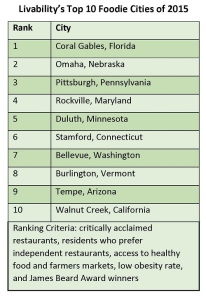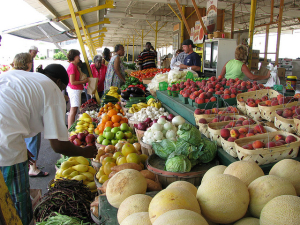
Family photo of the author making biscuits.
Ever since I was a little girl, some of my fondest memories include food, restaurant experiences, and cooking. Before I was tall enough to see the top of the kitchen counter, I was standing in a chair alongside my great grandmother pouring buttermilk into the morning’s batch of homemade biscuits. Those childhood experiences and my current love of food and cooking have led me to be a bit of a foodie.
In the past few years, the foodie movement has become more prevalent, and more and more people desire a more fulfilling experience with food and dining. In fact, a consumer trends study conducted by the National Association for the Specialty Food Trade (NASFT) states that 76% of U.S. adults enjoy talking about new and interesting foods. Food Technology Magazine sums up the foodie phenomenon nicely by stating, “A new, more sophisticated culinary ‘savoring’ food experience—defined by freshness, distinctive flavors, and storytelling about food—is moving center stage.” Food is no longer just sustenance necessary for everyday life. Now, food has the ability to affect many of our choices and important decisions, including where we choose to live.
 Many cities in the U.S. have been designated as “foodie cities” for their food-related amenities that are appealing to the 44 million Americans that call themselves true foodies. Livability.com has assessed the characteristics that make up a foodie city and created a list of the top 10 cities that are most pleasing to food lovers of all kinds. The best cities for food characteristically have a high percentage of local (non-chain) restaurants, farmers markets, wineries and breweries, a wide variety of diverse and unique food with bold flavors, embrace the farm to table movement, and host food-centered festivals and events. The table to the right lists Livability’s top 10 foodie cities of 2015 and the ranking criteria that were used.
Many cities in the U.S. have been designated as “foodie cities” for their food-related amenities that are appealing to the 44 million Americans that call themselves true foodies. Livability.com has assessed the characteristics that make up a foodie city and created a list of the top 10 cities that are most pleasing to food lovers of all kinds. The best cities for food characteristically have a high percentage of local (non-chain) restaurants, farmers markets, wineries and breweries, a wide variety of diverse and unique food with bold flavors, embrace the farm to table movement, and host food-centered festivals and events. The table to the right lists Livability’s top 10 foodie cities of 2015 and the ranking criteria that were used.
With so many great cities that cater to food lovers, which ones would be the best to actually live in? Foodies not only seek out unique restaurants while traveling, but also strive to cook with specialty, organic ingredients. Therefore, it is important for foodies to live in a location that can deliver fresh, unique ingredients as well as exceptional dining experiences. Today’s Specialty Food Consumer 2015 notes that specialty food consumers (a.k.a. foodies) are typically affluent individuals earning at least $75,000 per household and live either on the east or west coasts.

Farmers market by NatalieMaynor, CC BY 2.0.
Livability.com also developed a list of the top 100 places to live. This list is carefully constructed using a methodology shaped by the survey responses of 2,000 Americans about what is important in a place to live. These metrics capture traditional amenities such as housing prices and commute times, but they also consider more quality amenities. These better quality attributes include parks and farmers markets as well as arts and cultural amenities. The untraditional metrics used capture the presence of specialty food, diverse cuisine, and farm-fresh ingredients in each city.
Coming in at number 2 on the top 100 best places to live is Bellevue, Washington. Bellevue is also ranked as the number 7 foodie city. Walnut Creek, California, foodie city number 10, is also ranked in the top 100 cities to live at number 11. Conveniently located on the west coast, these cities would be ideal for foodies to consider living in and are likely home to some of the most persnickety food enthusiasts. A couple of east coast foodie cities, Rockville, Maryland and Stamford, Connecticut, also appear in the top 100 places to live. At numbers 17 and 98, respectively, these cities would be appealing to any east coast food lover. The hot real estate markets of the top cities further support the appeal of these locations.

Chocolate mousse cake courtesy of Lionel Allorge, CC BY-SA 3.0.
It is clear that the foodie movement is shaping the future of real estate in many ways. This article from the Wall Street Journal [subscription required] describes how residential real estate developers are locating homes and apartment buildings where specialty food is the most prevalent. Many are located within walking distance to farmers markets and local, unique eateries. Now more than ever, food enthusiasts want to live in cities where their passion for food can flourish. For real estate markets to keep up with the appetites of foodies, they must continue to adapt to the cultural, edible preferences of this niche market.
Foodies come in all forms—from enthusiastic chefs to gourmet cuisine lovers to organic and healthy eaters, and no matter what type of foodie one might claim to be, these top cities take the cake.





Recent Comments